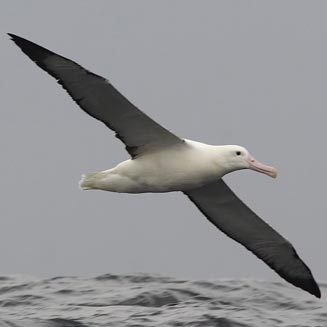|
Diomedea epomophora (Southern
royal albatross, Royal albatross)
Witvlerkkoningalbatros, Witvlerkkoningmalmok,
Koningmalmok [Afrikaans]; Koningsalbatros [Dutch]; Albatros royal
[French]; Königsalbatroß [German]; Albatroz-real [Portuguese]
Life
> Eukaryotes >
Opisthokonta
> Metazoa (animals) >
Bilateria >
Deuterostomia > Chordata >
Craniata > Vertebrata (vertebrates) > Gnathostomata (jawed
vertebrates) > Teleostomi (teleost fish) > Osteichthyes (bony fish) > Class:
Sarcopterygii (lobe-finned
fish) > Stegocephalia (terrestrial
vertebrates) > Tetrapoda
(four-legged vertebrates) > Reptiliomorpha > Amniota >
Reptilia (reptiles) >
Romeriida > Diapsida > Archosauromorpha > Archosauria >
Dinosauria
(dinosaurs) > Saurischia > Theropoda (bipedal predatory dinosaurs) >
Coelurosauria > Maniraptora > Aves
(birds) > Order: Ciconiiformes
> Family: Diomedeidae
 |
|
|
Southern royal albatross, offshore of Chile, South
America. [photo Pablo Caceres
©] |
|
Distribution and habitat
Breeds on Campbell and Auckland Island, south of New
Zealand, dispersing to the ocean surrounding southern South America and New
Zealand in the non-breeding season, sometimes passing through southern African
waters on its way, although there have only been a few records since 2000 off
the coast of Cape Town.
Food
It mainly eats squid (especially Moroteuthopsis ingens
and Kondakovia longimana), fish, crustaceans and tunicates.
Threats
Vulnerable due to mortalities on longlines and loss
of habitat at Campbell Island, New Zealand from the spread of the shrub
Dracophyllum.
References
-
Hockey PAR, Dean WRJ and Ryan PG 2005. Roberts
- Birds of southern Africa, VIIth ed. The Trustees of the John Voelcker
Bird Book Fund, Cape Town.
|
